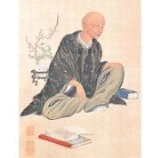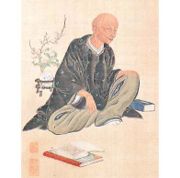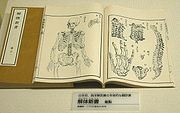
Sugita Genpaku
Encyclopedia

Kaitai Shinsho
is a medical text translated into Japanese during the Edo period. It is based on the Dutch-language translation Ontleedkundige Tafelen, often known in Japan as , of Kulmus’ German Anatomische Tabellen. As a full-blown translation from a Western language, it was the first of its kind in Japan...
(New Book of Anatomy
Anatomy
Anatomy is a branch of biology and medicine that is the consideration of the structure of living things. It is a general term that includes human anatomy, animal anatomy , and plant anatomy...
).
Besides Kaitai Shinsho, he also authored Rangaku
Rangaku
Rangaku is a body of knowledge developed by Japan through its contacts with the Dutch enclave of Dejima, which allowed Japan to keep abreast of Western technology and medicine in the period when the country was closed to foreigners, 1641–1853, because of the Tokugawa shogunate’s policy of national...
Kotohajime (Beginning of Dutch Studies).
Sugita assembled a team of Japanese translators and doctors to translate a Dutch
Dutch language
Dutch is a West Germanic language and the native language of the majority of the population of the Netherlands, Belgium, and Suriname, the three member states of the Dutch Language Union. Most speakers live in the European Union, where it is a first language for about 23 million and a second...
book of anatomy: Kulmus' "Ontleedkundige Tafelen". He did so because he found out, after an autopsy
Autopsy
An autopsy—also known as a post-mortem examination, necropsy , autopsia cadaverum, or obduction—is a highly specialized surgical procedure that consists of a thorough examination of a corpse to determine the cause and manner of death and to evaluate any disease or injury that may be present...
, that the western drawings of human organs were much more accurate than the ones in his Chinese
China
Chinese civilization may refer to:* China for more general discussion of the country.* Chinese culture* Greater China, the transnational community of ethnic Chinese.* History of China* Sinosphere, the area historically affected by Chinese culture...
handbooks. They tried to make a Japanese translation. At a rate of one page a week/month, the work was published in 1774. As an example of how difficult this work was, the collaborators had to study and discuss for several days before they realised that "neus" (nose) in Dutch, being a bulb on the front, meant hana (鼻) in Japanese
Japanese language
is a language spoken by over 130 million people in Japan and in Japanese emigrant communities. It is a member of the Japonic language family, which has a number of proposed relationships with other languages, none of which has gained wide acceptance among historical linguists .Japanese is an...
.

External links
- Kaitai shinsho. Selected pages scanned from the original work. Historical Anatomies on the Web. US National Library of Medicine.
- Online text of Genpaku's Rangaku Kotohajime (Dawn of Western Science in Japan)

